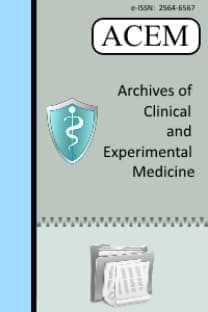Karaciğer hidatik kist cerrahisi sonrası oluşan safra fistülünün gelişimindeki risk faktörlerinin retrospektif analizi
Karaciğer kist hidatik hastalığı, safra fistülü, Echinococcus granulosus
Retrospective analysis of risk factors for development of biliary fistula after liver cyst hydatid surgery
___
- 1. Jenkins DJ, Romig T, Thompson RC. Emergence/re-emergence of Echinococcus spp.—a global update. Int J Parasitol. 2005;35:1205-19.
- 2. Romig T, Dinkel A, Mackenstedt U. The present situation of echinococcosis in Europe. Parasitol Int. 2006;55:187.
- 3. Alper A, Arioglu O, Emre A, Uras A, Okten A. Choledochoduodenostomy for intrabiliary rupture of hydatid cyst of liver. Br J Surg. 1987;74:243–5.
- 4. Atahan K, Kupeli H, Deniz M, Gur S, Cokmez A, Tarcan E. Can occult cystobiliary fistulas in hepatic hydatid disease be predicted before surgery? Int J Med Sci. 2011;8:315-20.
- 5. Vicente E, Meneu JC, Hervas PL, Nuno J, Quijano Y, Devesa M, et al. Management of biliary duct confluence injuries produced by hepatic hydatidosis. World J Surg. 2001;25:1264-9.
- 6. Karabay Ö, Bostancı Ö. Biliary fistula after liver hydatid cyst surgery: Is it a predictable complication? Arch Clin Exp Med. 2018;3:186-9.
- 7. Saylam B, Coşkun F, Demiriz B, Vural V, Çomçalı B, Tez M. A new and simple score for predicting cystobiliary fistula in patients with hepatic hydatid cysts. Surgery, 2013;153:699-704.
- 8. Alan B, Kapan M, Teke M, Hattapoğlu S, Arıkanoglu Z. Value of cyst localization to predict cystobiliary communication in patients undergoing conservative surgery with hydatid cyst. Ther Clin Risk Manag. 2016;12:995-1001.
- 9. Manouras A, Genetzakis M, Antonakis PT, Lagoudianakis E, Pattas M, Papadima A, et al. Endoscopic management of a relapsing hepatic hydatid cyst with intrabiliary rupture: a case report and review of the literature. Can J Gastroenterol. 2007;21:249-53.
- 10. Erden A, Ormeci N, Fitoz S, Erden I, Tanju S, Genç Y. Intrabiliary rupture of hepatic hydatid cysts: diagnostic accuracy of MR cholangiopancreatography. AJR Am J Roentgenol. 2007;189:W84-9.
- 11. Chautems R, Buehler LH, Gold B, Chilcott MJ, Morel P, Mentha G. Long term results after complete or incomplete surgical resection of liver hydatid disease. Swiss Med Wkly. 2003;133:258-62.
- 12. Gharbi HA, Hassine W, Brauner MW, Dupuch K. Ultrasound examination of the hydatic liver. Radiology. 1981;139:459-63.
- 13. Daradkeh S, Husam EM, Farah G, Sroujieh AS, Abu-Khalaf M. Predictors of morbidity and mortality in the surgical management of hydatid cyst of the liver. Langenbeck's Arch Surg. 2007;392:35-9.
- 14. Valle-Sanz Yd Y, Lorente-Ramos RM. Sonographic and computed tomographic demonstration of hydatid cysts communicating with the biliary tree. J Clin Ultrasound. 2004;32:144–8.
- 15. Demircan O, Baymus M, Seydaoglu G, Akinoglu A, Sakman G. Occult cystobiliary communication presenting as postop- erative biliary leakage after hydatid liver surgery: are there significant preoperative clinical predictors? Can J Surg. 2006;49:177-84.
- 16. Yildirgan MI, Başoğlu M, Atamanalp SS, Aydinli B, Balik AA, Celebi F, Ören D. Intrabiliary rupture in liver hydatid cysts: results of 20 years’ experience. Acta Chir Belg. 2003;103:621-5.
- 17. Frider B, Larrieu E, Odriozola M. Long-term outcome of asymptomatic liver hydatidosis. J Hepatol. 1999;30:228-31.
- 18. Moro PL, Lopera L, Bonifacio N, Gonzales A, Gilman RH, Moro MH. Risk factors for canine echinococcosis in an endemic area of Peru. Vet Parasitol. 2005:130:99-104.
- 19. Kilic M, Yoldas O, Koc M, Keskek M, Karakose N, Ertan T, Tez M. Can biliary-cyst communication be predicted before surgery for hepatic hydatid disease: does size matter? The Am J Surg. 2008;196:732-5.
- 20. Agarwal S, Sikora SS, Kumar A, Saxena R, Kapoor VK.. Bile leaks following surgery for hepatic hydatid disease. Indian J Gastroenterol. 2005;24:55–8.
- 21. Atli M, Kama NA, Yuksek YN, Doganay M, Gozalan U, Kologlu M, et al. Intrabiliary rupture of a hepatic hydatid cyst: associated clinical factors and proper management. Arch Surg. 2001;136:1249-55.
- 22. Kayaalp C, Bzeizi K, Demirbag AE, Akoglu M. Biliary com- plications after hydatid liver surgery: incidence and risk fac- tors. J Gastrointest Surg. 2002;6:706-12.
- 23. Unalp HR, Baydar B, Kamer E, Yilmaz Y, Issever H, Tarcan E. Asymptomatic occult cysto-biliary communication with- out bile into cavity of the liver hydatid cyst: a pitfall in conservative surgery. Int J Surg. 2009;7:387-91.
- ISSN: 2564-6567
- Yayın Aralığı: 3
- Başlangıç: 2016
- Yayıncı: -
Surgicel ® kullanımının epistaksis kontrolünde nazal tampon ile karşılaştırılması
Tevfik SÖZEN, Övsen ÖNAY, Seyit Mehmet CEYLAN
Migren hastalarında enflamatuvar belirteçlerin değerlendirilmesi
Aysel TEKESİN, ABDÜLKADİR TUNÇ
Mehmet Hakan ÖNCEL, Cemal TUNCER
Emin KÖSE, Nilay Tuğba BAZ, Deniz TAZEOĞLU, Mehmet Emin GÜRBÜZ, Hasan TOK, Ayhan ÖZSOY, Servet Rüştü KARAHAN
Habibullah AKTAŞ, Aybala CEBECİK
Dorsal yaklaşım ile Morton nöroma eksizyonu cerrahisi orta dönem sonuçları
